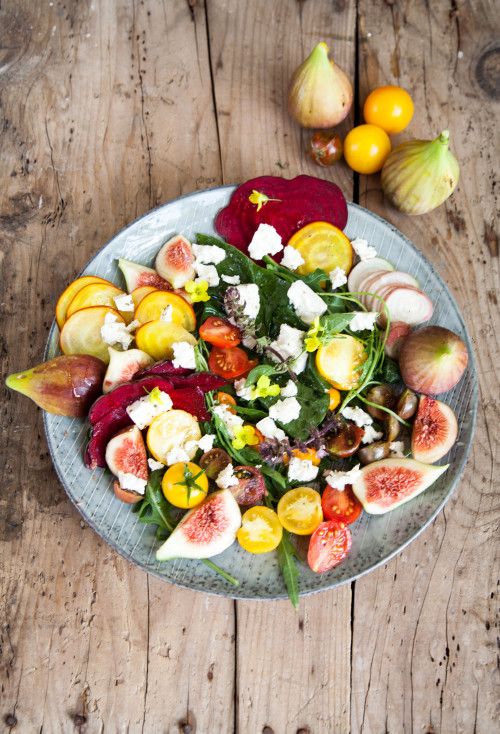Colourful Root Vegetable and Fig Salad
Figs intrigue me. They're not just delicious, they're sensuous. Something about them fascinates me, but I can't really put my finger on what it is.
I didn't used to think figs were sensuous at all, quite the contrary. But when I was a kid, the only figs I had come across were dried ones. My grandmother always thought they were particularly good for digestion. Of course I didn't care about this at all and it's also not a particularly sexy bit of trivia, but I've always enjoyed them as a snack. Once I started traveling, I got to know and love fresh figs as well, and a few weeks ago, I got to pick them myself for the first time when I visited my fellow blogger Melanie of Mundwerk fame in Burgenland.
I've already announced a second recipe following the plum cake from recently. And it's high time, because at this point in time, figs are either overripe or have already been harvested and processed. So let's get on with this recipe.
Figs are especially interesting to me because they're so diverse. You can eat them with goat's or sheep's cheese, drizzled with a little honey, or you can mix them in with roast vegetables for a bit of sweetness. They are delicious caramelised with honey or as a breakfast dish, mixed under cereal or granola. I also love them in tarts and, using the dried variety, as an aromatic ingredient in cakes and bread. I love this fruit, no matter what or how. And above all that, they are very beautiful: dark purple on the outside and wonderfully red and soft on the inside.
Figs don't just look beautiful and delicious though, they are also very good for you, containing, as they do, many healthy ingredients. Figs have always been known for their healing properties. They don't merely pack fructose and fibre, but also iron, potassium, calcium and vitamin B1. They contain a lot of water, almost 80%, and are said to have blood-purifying and digestive properties as well as act as a diuretic. The nutrient concentration is higher in dried figs than in fresh ones so their effect and energy content are also increased. It's good to know that figs are the most alkaline of foods around, so they are ideal for neutralising acidic dishes - this is key for people who eat a lot of meat and sausages and not enough fruit and veggies.
I enjoyed the afternoon at Melanie's immensely. To just take a little basket, go into the garden, pick some figs from the tree, then go on to one of the fields and harvest your own Swiss chard and aromatic, fresh rocket, pull the turnips, pick fresh tomatoes right from the bush, is a huge privilege. Once you've harvested these beauties with your own hands, you really look forward to cooking them. After Meli and I spread our haul out on the table in front of us and saw all the textures and colours, we knew without a doubt that it just had to be a colourful autumn salad. We also made some delicious Swiss chard crisps to go along with it, after a delicious recipe Meli provided - very yummy and surprisingly different and so easy to prepare. So get yourself to the nearest market or vegetable garden and make use of this colourful veg variety still on offer this season. They're not just good for us but also a feast for the eyes. Enjoy!
Colourful Root Vegetable and Fig Salad with Swiss Chard Crisps
2 people
Ingredients:
- 1 beetroot
- 1 yellow carrot
- 1 turnip
- 6 figs
- 2 handful of multi-coloured cherry tomatoes
- 1 bunch of fresh, aromatic rocket
- 100g goat's cheese
- 2 tsp honey
- 3 TBSP olive oil
- 2 TBSP balsamic vinegar
- salt and pepper
- for decoration (optional): rocket flowers and basil flowers
- 6 large leaves of Swiss chard
- olive oil to drizzle
- herb-infused sea salt
Preparation:
- For the salad, wash the root vegetables and top and tail them. Very finely slice them with a sharp knife or the slicing edge of a grater. Wash and halve the cherry tomatoes. Wash and quarter the figs.
- Wash and shake dry the rocket and arrange on plates. Creatively top with root vegetables, figs, tomatoes and flowers.
- Crumble some goat's cheese over the dish with your hands and drizzle with honey. Season with olive oil, balsamic vinegar, salt and pepper and garnish with edible flowers. Serve.
- For the crisps, preheat the oven to 180°C (upper/lower). Pick the Swiss chard leaves from the wooden stems and shred coarsely. The size of your shreds should roughly correspond to the desired crisp size.
- Place the Swiss chard pieces in a bowl and add 2 TBSP of olive oil. It's important that the leaves are well coated with oil on both sides. Season with a little sea salt and mix well.
- Spread the crisps on a parchment-covered baking sheet and bake in the preheated oven for 10-15 minutes until crispy. You might want to turn them once, halfway through.
















